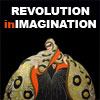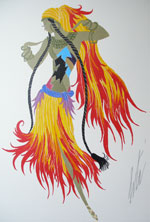Costume Designs by Erté
Erté has often been called the “Father of Art Deco,” the style that came into vogue internationally in the 1920’s. At the time of his death at the age of 98, he was considered one of the most influential artists of the 20th Century.
Erté’s world of fantasy was formed in his childhood when he spent countless hours immersed in a book of Persian miniatures in his father’s library or transfixed by the delicate lines of the figures on Greek vases in the Heritage Museum. Fascinated by the ballet and opera in St. Petersburg, he was also strongly influenced by the Ballets Russes in Paris. Unlike many artists who work freely before a canvas or sketchpad, Erté developed his own unique process: he would visualize the entire work of art in his mind until it was completed to every detail, and then create the work from his “mind’s eye.”
Erté’s theatrical costume was characterized by rich and vibrant color - color that gave the costume a commanding presence and confirmed its identity as a work of art. A designer’s participation is critically important to the success of the costumes. Erté was involved in the smallest detail.
Erté was meticulous; the countless hours he spent in realizing his exacting sketches are incalculable, and could only have been accomplished by complete absorption in the project at hand. Very fine lines were painted (rather than drawn) with brushes and gouache. Pearls and jewels emerged from a painstaking application of minute dots of paint in multiple layers. Erté’s drawings are characterized by his delicately fluid serpentine line, which possesses a concentrated energy that conveys a sense of motion even within the most confined spaces. His works are completely two dimensional, yet the volume and form of the figure emerge without the use of shading. A careful attention to detail is always evident; the smallest ornaments or satellite elements of construction are rendered with precision. It is apparent that Erté’s designs were innovative, decorative, and ahead of his time. His delicate figures and sophisticated, glamorous designs are instantly recognizable, and his ideas and art still influence fashion into the 21st century. Erté seemed to go places in fashion no other designers had gone before. His designs live on as a memorial to one of the most imaginative and exciting artists that has ever lived.
Images created by Erté influenced dance costuming, both directly through his own designs, and indirectly by establishing the silhouettes, the “lines,” the “dancerly look.” His costume ideas have been emulated and echoed by dancers and dance theaters of all genres and styles – ballet, modern, belly dancers, Las Vegas showgirls and drag queens.



